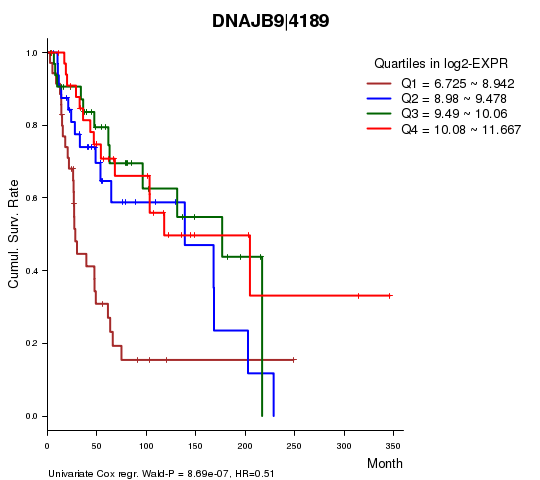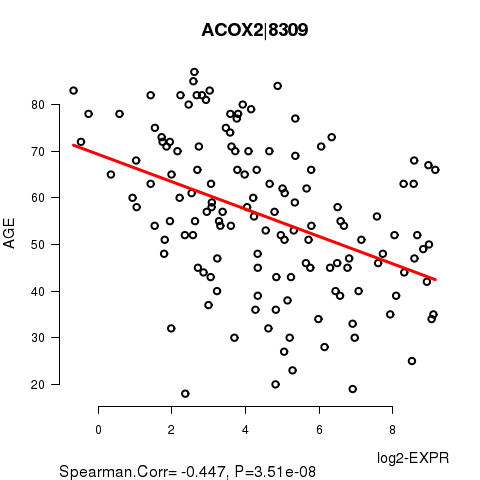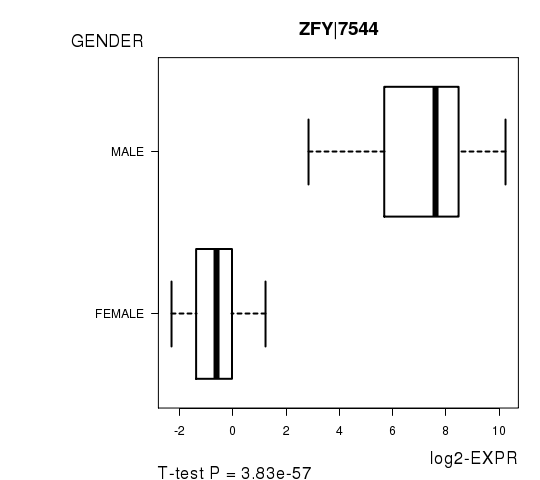This pipeline uses various statistical tests to identify mRNAs whose expression levels correlated to selected clinical features.
Testing the association between 18092 genes and 3 clinical features across 141 samples, statistically thresholded by Q value < 0.05, 3 clinical features related to at least one genes.
-
4 genes correlated to 'Time to Death'.
-
DNAJB9|4189 , ZNF25|219749 , PRKAR2B|5577 , EID1|23741
-
1 gene correlated to 'AGE'.
-
ACOX2|8309
-
17 genes correlated to 'GENDER'.
-
ZFY|7544 , XIST|7503 , PRKY|5616 , RPS4Y1|6192 , CYORF15B|84663 , ...
Complete statistical result table is provided in Supplement Table 1
Table 1. Get Full Table This table shows the clinical features, statistical methods used, and the number of genes that are significantly associated with each clinical feature at Q value < 0.05.
| Clinical feature | Statistical test | Significant genes | Associated with | Associated with | ||
|---|---|---|---|---|---|---|
| Time to Death | Cox regression test | N=4 | shorter survival | N=0 | longer survival | N=4 |
| AGE | Spearman correlation test | N=1 | older | N=0 | younger | N=1 |
| GENDER | t test | N=17 | male | N=12 | female | N=5 |
Table S1. Basic characteristics of clinical feature: 'Time to Death'
| Time to Death | Duration (Months) | 0.2-346 (median=47.5) |
| censored | N = 70 | |
| death | N = 68 | |
| Significant markers | N = 4 | |
| associated with shorter survival | 0 | |
| associated with longer survival | 4 |
Table S2. Get Full Table List of 4 genes significantly associated with 'Time to Death' by Cox regression test
| HazardRatio | Wald_P | Q | C_index | |
|---|---|---|---|---|
| DNAJB9|4189 | 0.51 | 8.695e-07 | 0.016 | 0.329 |
| ZNF25|219749 | 0.61 | 1.176e-06 | 0.021 | 0.344 |
| PRKAR2B|5577 | 0.69 | 1.571e-06 | 0.028 | 0.336 |
| EID1|23741 | 0.5 | 2.398e-06 | 0.043 | 0.336 |
Figure S1. Get High-res Image As an example, this figure shows the association of DNAJB9|4189 to 'Time to Death'. four curves present the cumulative survival rates of 4 quartile subsets of patients. P value = 8.69e-07 with univariate Cox regression analysis using continuous log-2 expression values.

Table S3. Basic characteristics of clinical feature: 'AGE'
| AGE | Mean (SD) | 56.06 (16) |
| Significant markers | N = 1 | |
| pos. correlated | 0 | |
| neg. correlated | 1 |
Table S4. Get Full Table List of one gene significantly correlated to 'AGE' by Spearman correlation test
| SpearmanCorr | corrP | Q | |
|---|---|---|---|
| ACOX2|8309 | -0.4468 | 3.514e-08 | 0.000636 |
Figure S2. Get High-res Image As an example, this figure shows the association of ACOX2|8309 to 'AGE'. P value = 3.51e-08 with Spearman correlation analysis. The straight line presents the best linear regression.

Table S5. Basic characteristics of clinical feature: 'GENDER'
| GENDER | Labels | N |
| FEMALE | 50 | |
| MALE | 91 | |
| Significant markers | N = 17 | |
| Higher in MALE | 12 | |
| Higher in FEMALE | 5 |
Table S6. Get Full Table List of top 10 genes differentially expressed by 'GENDER'
| T(pos if higher in 'MALE') | ttestP | Q | AUC | |
|---|---|---|---|---|
| ZFY|7544 | 29.49 | 3.831e-57 | 6.93e-53 | 0.998 |
| XIST|7503 | -20.36 | 9.187e-41 | 1.66e-36 | 0.9781 |
| PRKY|5616 | 23.89 | 1.447e-40 | 2.62e-36 | 0.9987 |
| RPS4Y1|6192 | 27 | 1.446e-36 | 2.61e-32 | 1 |
| CYORF15B|84663 | 30.53 | 4.471e-34 | 8.08e-30 | 1 |
| DDX3Y|8653 | 28.33 | 1.248e-30 | 2.26e-26 | 1 |
| KDM5D|8284 | 27.15 | 5.568e-25 | 1.01e-20 | 1 |
| TSIX|9383 | -13.94 | 4.454e-24 | 8.05e-20 | 0.9754 |
| EIF1AY|9086 | 25.39 | 1.164e-19 | 2.1e-15 | 1 |
| TTTY15|64595 | 21.69 | 3.336e-19 | 6.03e-15 | 0.9976 |
Figure S3. Get High-res Image As an example, this figure shows the association of ZFY|7544 to 'GENDER'. P value = 3.83e-57 with T-test analysis.

-
Expresson data file = SKCM-TM.uncv2.mRNAseq_RSEM_normalized_log2.txt
-
Clinical data file = SKCM-TM.clin.merged.picked.txt
-
Number of patients = 141
-
Number of genes = 18092
-
Number of clinical features = 3
For survival clinical features, Wald's test in univariate Cox regression analysis with proportional hazards model (Andersen and Gill 1982) was used to estimate the P values using the 'coxph' function in R. Kaplan-Meier survival curves were plot using the four quartile subgroups of patients based on expression levels
For continuous numerical clinical features, Spearman's rank correlation coefficients (Spearman 1904) and two-tailed P values were estimated using 'cor.test' function in R
For two-class clinical features, two-tailed Student's t test with unequal variance (Lehmann and Romano 2005) was applied to compare the log2-expression levels between the two clinical classes using 't.test' function in R
For multiple hypothesis correction, Q value is the False Discovery Rate (FDR) analogue of the P value (Benjamini and Hochberg 1995), defined as the minimum FDR at which the test may be called significant. We used the 'Benjamini and Hochberg' method of 'p.adjust' function in R to convert P values into Q values.
This is an experimental feature. The full results of the analysis summarized in this report can be downloaded from the TCGA Data Coordination Center.